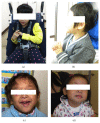Angelman-Like Syndrome: A Genetic Approach to Diagnosis with Illustrative Cases
- PMID: 26942024
- PMCID: PMC4749774
- DOI: 10.1155/2016/9790169
Angelman-Like Syndrome: A Genetic Approach to Diagnosis with Illustrative Cases
Abstract
Epigenetic abnormalities in 15q11-13 imprinted region and UBE3A mutation are the two major mechanisms for molecularly confirmed Angelman Syndrome. However, there is 10% of clinically diagnosed Angelman Syndrome remaining test negative. With the advancement of genomic technology like array comparative genomic hybridization and next generation sequencing methods, it is found that some patients of these test negative Angelman-like Syndromes actually have alternative diagnoses. Accurate molecular diagnosis is paramount for genetic counseling and subsequent management. Despite overlapping phenotypes between Angelman and Angelman-like Syndrome, there are some subtle but distinct features which could differentiate them clinically. It would provide important clue during the diagnostic process for clinicians.
Figures
References
LinkOut - more resources
Full Text Sources
Other Literature Sources



